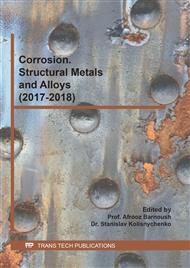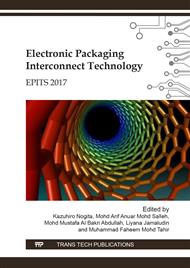[1]
M. Hindler, Z. Guo, A. Mikula, Lead-free solder alloys: Thermodynamic properties of the (Au+ Sb+ Sn) and the (Au+ Sb) system, The Journal of chemical thermodynamics, 55 (2012) 102-109.
DOI: 10.1016/j.jct.2012.06.024
Google Scholar
[2]
U.S. Mohanty, K.-L. Lin, Electrochemical corrosion behaviour of Pb-free Sn–8.5 Zn–0.05 Al–XGa and Sn–3Ag–0.5 Cu alloys in chloride containing aqueous solution, Corrosion Science, 50 (2008) 2437-2443.
DOI: 10.1016/j.corsci.2008.06.042
Google Scholar
[3]
M.F.M. Nazeri, A.A. Mohamad, Corrosion measurement of Sn–Zn lead-free solders in 6 M KOH solution, Measurement, 47 (2014) 820-826.
DOI: 10.1016/j.measurement.2013.10.002
Google Scholar
[4]
M.F.M. Nazeri, A.A. Mohamad, Effect of Corrosion in Alkaline Solution to the Microstructure and Mechanical Properties of Cu/Sn-9Zn/Cu, Procedia Chemistry, 19 (2016) 247-252.
DOI: 10.1016/j.proche.2016.03.101
Google Scholar
[5]
M. Yang, H. Ji, S. Wang, Y.-H. Ko, C.-W. Lee, J. Wu, M. Li, Effects of Ag content on the interfacial reactions between liquid Sn–Ag–Cu solders and Cu substrates during soldering, Journal of Alloys and Compounds, 679 (2016) 18-25.
DOI: 10.1016/j.jallcom.2016.03.177
Google Scholar
[6]
M. Abtew, G. Selvaduray, Lead-free solders in microelectronics, Mater. Sci. Eng. R-Rep., 27 (2000) 95-141.
DOI: 10.1016/s0927-796x(00)00010-3
Google Scholar
[7]
K. Suganuma, Advances in lead-free electronics soldering, Curr. Opin. Solid State Mater. Sci. , 5 (2001) 55-64.
Google Scholar
[8]
K. Suganuma, K.-S. Kim, Sn-Zn low temperature solder, in: Lead-Free Electronic Solders, Springer, 2007, pp.121-127.
DOI: 10.1007/978-0-387-48433-4_7
Google Scholar
[9]
M.F.M. Nazeri, M.G. Affendy, A.A. Mohamad, Corrosion Study of Sn-9Zn Lead-Free Solder in Alkaline Solution, Int. J. Electrochem. Sci, 7 (2012) 4182-4191.
Google Scholar
[10]
M.F.M. Nazeri, A.A. Mohamad, Polarization Study of Sn-9Zn Lead-free Solder in KOH Solutions, Int. J. Electroactive Mater, 2 (2014) 34-39.
Google Scholar
[11]
K.-L. Lin, F.-C. Chung, T.-P. Liu, The potentiodynamic polarization behavior of Pb-free XIn-9 (5Al-Zn)-YSn solders, Mater. Chem. Phys., 53 (1998) 55-59.
DOI: 10.1016/s0254-0584(97)02062-2
Google Scholar
[12]
K.-L. Lin, T.-P. Liu, The electrochemical corrosion behaviour of Pb-free Al-Zn-Sn solders in NaCl solution, Mater. Chem. Phys., 56 (1998) 171-176.
DOI: 10.1016/s0254-0584(98)00171-0
Google Scholar
[13]
J.-C. Liu, Z.-H. Wang, J.-Y. Xie, J.-S. Ma, Q.-Y. Shi, G. Zhang, K. Suganuma, Effects of intermetallic-forming element additions on microstructure and corrosion behavior of Sn–Zn solder alloys, Corrosion Science, 112 (2016) 150-159.
DOI: 10.1016/j.corsci.2016.07.004
Google Scholar
[14]
J.-C. Liu, G. Zhang, J.-S. Ma, K. Suganuma, Ti addition to enhance corrosion resistance of Sn–Zn solder alloy by tailoring microstructure, Journal of Alloys and Compounds, 644 (2015) 113-118.
DOI: 10.1016/j.jallcom.2015.04.168
Google Scholar
[15]
J.-C. Liu, G. Zhang, S. Nagao, J.-T. Jiu, M. Nogi, T. Sugahara, J.-S. Ma, K. Suganuma, Metastable pitting and its correlation with electronic properties of passive films on Sn–xZn solder alloys, Corrosion Science, 99 (2015) 154-163.
DOI: 10.1016/j.corsci.2015.06.036
Google Scholar
[16]
M.F.M. Nazeri, A.B. Ismail, A.A. Mohamad, Effect of polarizations on Sn–Zn solders alloys in alkaline electrolyte, J. Alloy. Compd., 606 (2014) 278-287.
DOI: 10.1016/j.jallcom.2014.04.034
Google Scholar
[17]
M.F.M. Nazeri, A.A. Mohamad, Effect of exposure to alkaline solution on Sn–9Zn solder joints, J. Mater. Process. Technol. , 219 (2015) 164-172.
DOI: 10.1016/j.jmatprotec.2014.12.018
Google Scholar
[18]
M. Mori, K. Miura, T. Sasaki, T. Ohtsuka, Corrosion of tin alloys in sulfuric and nitric acids, Corrosion Sci., 44 (2002) 887-898.
DOI: 10.1016/s0010-938x(01)00094-4
Google Scholar
[19]
M.F.M. Nazeri, A.A. Mohamad, Corrosion resistance of ternary Sn-9Zn-xIn solder joint in alkaline solution, Journal of Alloys and Compounds, 661 (2016) 516-525.
DOI: 10.1016/j.jallcom.2015.11.184
Google Scholar
[20]
J.-C. Liu, S. Park, S. Nagao, M. Nogi, H. Koga, J.-S. Ma, G. Zhang, K. Suganuma, The role of Zn precipitates and Cl− anions in pitting corrosion of Sn–Zn solder alloys, Corrosion Science, 92 (2015) 263-271.
DOI: 10.1016/j.corsci.2014.12.014
Google Scholar



